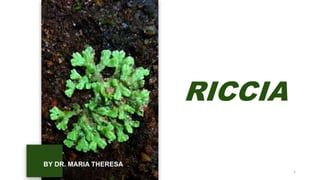
Riccia
- 1. RICCIA BY DR. MARIA THERESA 1
- 2. SYSTEMATIC POSITION Genus : Riccia Division : Bryophyta Family : Ricciaceae Order : Marchantiales Class : Hepaticopsida 2
- 3. General Characteristics • Most widely distributed genus of the family Ricciaceae consisting of 200 species of which 35 are from India • Named in the honour of P F Ricci. • Most of the species are terrestrial, which grows in damp places but, Riccia fluitans is an aquatic species. • Examples of a few Indian species are; R. gangetica, R. discolor, R. himalayensis, R. glauca, R. crystallina, R. frostii, R. hirsuta, R. melanospora. , R. kashyapii and R. pandei. • Plant body shows alternate generation. 3
- 4. Gametophytic Generation • The plant body of Riccia is gametophytic. • Thallus is small, flat, dorsiventral, fleshy, prostrate and dichotomously branched. Dichotomy leads to the rosette like appearance. • Dorsal surface Light green in colour. Thick midrib. Median longitudinal groove ending in a depression call apical notch. Growing point situated in apical notch. • Ventral surface The ventral surface of thallus bears many scales and rhizoids. Scales are multicellular and one celled thick structures. Scales are arranged along the margin in a single row. Rhizoids are unicellular and un-branched. 4 Dorsal groove Apical notch
- 5. Anatomy of Gametophytic thallus • The green photosynthetic region made up of unbranched photosynthetic filaments separated by narrow air chambers. • All the cells of the photosynthetic filament except the uppermost one are isodiametric and possess many chloroplasts. • Terminal cells are large, hyaline and makes a discontinuous epidermis. Upper Photosynthetic Zone • This zone lies below the photosynthetic zone. • It consists of compactly arrangedparenchymatouscells devoid of chloroplast • Contain starch as reserved food material. The lowermost cell layer of this zone forms the lower epidermis. • Some cells extend to form the scales and both types of rhizoids. Lower Storage Zone 5
- 6. Scales and Rhizoids • Rhizoids are of two types: o Tuberculate – the inner wall layer modifies into peg-like in growth which projects into the cell lumen. It helps in anchorage. o Smooth walled – both inner and outer walls are smooth. It helps in absorption. • Scales: o Present on ventral side. o Two types – simple and ligulate. o Helps to protect growing point. 6
- 7. Reproduction 1. Vegetative Reproduction Fragmentation Death and decay of older portions Formation of adventitious branches. Persistent growing apices. Formation of tubers. By rhizoids. 2. Sexual reproduction Sexual reproduction in Riccia is oogamous. Male reproductive bodies are known as antheridia and female as archegonia. Some species of Riccia like R. crystallina, R. gangetica, etc. are monoecious or homothallic while other species like R. frostii, R. discolor, etc. are dioecious or heterothallic. Antheridia and archegonia remain enclosed with in the antheridial and archegonial chambers and develop on the dorsal surface of the thallus. Sex organs develop in acropetal succession. 7
- 8. Antheri dium 8 Antheridum Basal stalk Oval body • Short • Stalk attaches the antheridium to the base of the antheridial chamber. • It has a flat base with conical apex. • A single-layered sterile jacket encloses the mass of androcytes which metamorphoses into antherozoids. • Antheridium is present singly in an antheridial chamber.
- 9. Spermatog enesis 9 1Androcyte mother cell 2 triangularand rocyte Ovalandroc yte Blepharoplast elongates Crescent shaped nucleus 2 flagella fromblephar oplast Matureanther ozoid • A mature antherozoid is unicellular, uninucleate, biflagellate and coiled structure. • Both flagella resemble morphologically but differ in function i.e., one for propulsion and other for rotation.
- 10. Dehiscence of Antheridium • Antheridium dehisce in the presence of water. • Water enters the antheridial chamber and the sterile apical cells of the antheridial jacket enlarge by absorbing water and ultimately breaks open. • The cell walls form the semifluid content. • The mature antherozoids along with semifluid mass, come out of the antheridium to the antheridial chamber and then to the dorsal surface of the thallus. 10
- 11. Archegonium 11 Archegonium Stalk Neck Venter • Short • Helps to remain attached to the thallus. • Elongated, slender neck. • Six vertical rows of cell enclose 4 – 6 neck canal cells. • Single layered ventral wall. • Single, small ventral canal cell. • Single, large egg.
- 12. Fertilization • The antherozoids released after dehiscence swim on the dorsal surface of the thallus and reach the mouth of the archegonium. • The ventral canal cell and neck canal cell disintegrates forming a mucilaginous mass which absorbs water, swells up and opens the cover cell apart. • Many antherozoids enter the archegonial neck. • One of the antherozoid fertilize the egg. Male and female gamete nuclei fuse to form a diploid zygote. • This marks the end of gametophytic phase. 12
- 13. Sporophytic Generation • The mature Sporophyte has a globular capsule embedded within the dorsal surface of the gametophytic thallus. • Foot and seta are completely absent. • The capsule has a single layered capsule jacket and is also covered by a bilayered calyptra. • Before sporogenesis, the capsule wall and inner layer of calyptra disintegrates. • Spores are the first cell of the gametophytic generation. Each spore has 3 wall layers, namely exosporium, mesosporium & endosporium. They are liberated after the complete death and decay of the older gametophyte. • Spores are liberated by wind or rain. 13
- 16. 16 Life Cycle
- 17. Thank You 17